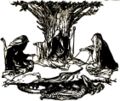Arthur Rackham
Arthur Rackham (September 19, 1867 – September 6, 1939) was a prolific English book illustrator.
Life
He was born in London as one of 12 children. At the age of 18, he worked as a clerk at the Westminster Fire Office and began studying at the Lambeth School of Art. In 1892 he quit his clerk job and started working for The Westminster Budget as a reporter and illustrator. His first book illustrations were published in 1893. From then, until his death in 1939, he illustrated numerous books.
In 1903, he married Edyth Starkie, with whom he had one daughter, Barbara, in 1908. Rackham won a gold medal at the Milan International Exhibition in 1906 and another one at the Barcelona International Exposition in 1911. His works were included in numerous exhibitions, including one at the Louvre in Paris in 1914. Arthur Rackham died 1939 of cancer in his home in Limpsfield, Surrey.
Works
Major works of illustration by Arthur Rackham include the children's books Fairy Tales of the Brothers Grimm (1900), Rip van Winkle (1905), Peter Pan in Kensington Gardens (50 colour plates) (1906), and Alice's Adventures in Wonderland (13 colour plates) (1907). While he may be best known for his elaborate illustrations of children's literature and fairy tales, he also illustrated books for adult readers, including A Midsummer Night's Dream (40 colour plates) (1908), Undine (15 colour plates) (1909), the text to Richard Wagner's opera cycle "Der Ring des Nibelungen" ("The Ring of the Nibelung") (34 colour plates to The Rhinegold & The Valkyrie (1910) and 32 colour plates to Siegfried & The Twilight of the Gods (1911))(1911), short stories by Edgar Allan Poe. Further works include The Romance of King Arthur and His Knights of the Round Table (23 colour and monotone plates)(1917), The Springtide of Life (8 colour plates) (1918), Hawthorne's Wonder Book (16 colour plates) (1922) and The Tempest (20 colour plates) (1926).
Typically, Rackham contributed both colour and monotone illustrations towards the works incorporating his images - and in the case of Hawthorne's Wonder Book, he also provided a number of part-coloured block images similar in style to Meiji-era Japanese woodblocks.
Gallery
-
"Fee-fi-fo-fum, I smell the blood of an Englishman."
Illustration to a 1918 English Fairy Tales, by Flora Annie Steel -
"How at the Castle of Corbin a Maiden Bare in the Sangreal and Foretold the Achievements of Galahad", from The Romance of King Arthur and His Knights of the Round Table, by Alfred W. Pollard, 1917
-
"The giant Galligantua and the wicked old magician transform the duke's daughter into a white hind", Illustration to English Fairy Tales, by Flora Annie Steel
-
"The giant Cormoran was the terror of all the country-side.", Illustration to English Fairy Tales, by Flora Annie Steel
-
"The Three Bears", Illustration to English Fairy Tales, by Flora Annie Steel
-
"Norns weaving destiny" Illustration to Richard Wagner's "The Ring"
-
"Rhine maidens warn Siegfried" Illustration to Richard Wagner's "The Ring"
-
"The Rhinemaidens try to reclaim their gold" Illustration to Richard Wagner's "The Ring"
-
"The Twa Corbies", Illustration to Some British Ballads
-
David, Illustration to Peter Pan in Kensington Gardens
Influence
In one of the featurettes on the DVD of Pan's Labyrinth, director Guillermo Del Toro cites Rackham as an influence on the design of "The Faun" and other creatures in the film. He liked the dark tone of Rackham's gritty realistic drawings and had decided to incorporate this into the film.
External links
- Works by Arthur Rackham at Project Gutenberg
- The Arthur Rackham Society
- Collection of more than 200 plates from Peter Pan in Kensington Gardens, Alices Adventures in Wonderland, A Midsummer Nights Dream, Undine, The Rhinegolde & The Valkyrie, Siegfried & The Twilight of the Gods, The Romance of King Arthur and His Knights of the Round Table, The Springtide of Life, Hawthornes Wonder Book and The Tempest from Spirit of the Ages
- Arthur Rackham and his art
- The Illustrators Project: Arthur Rackham
- Alice's Adventures in Wonderland, illustrated by Arthur Rackham
- Arthur Rackham art at Art Passions (free online gallery)
- SurLaLune Fairy Tale Pages: Fairy Tale Illustrations of Arthur Rackham
- Children's Book Illustrators Gallery - Large Archive of Rackham's First edition illustrations
- Update to Arthur Rackham bibliography in "Studies in Illustration"













